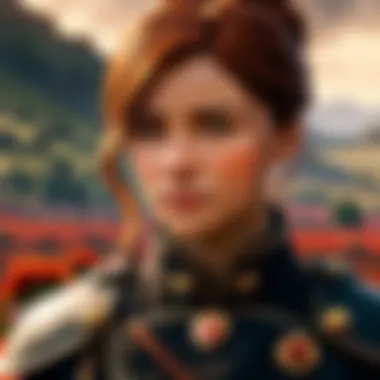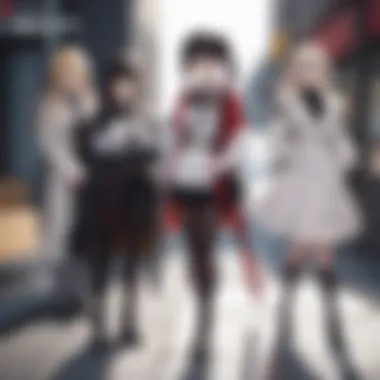Exploring Love is War Season Three: Themes and Impact


Intro
The world of anime is often intertwined with intricate storytelling, a vibrant cast of characters, and themes that resonate deeply with audiences. One such series that shines in the crowded anime landscape is 'Love is War'. As we gear up to explore Season Three, it becomes essential to unpack the nuances that make this installment compelling. This season is not merely about romance; it’s a battlefield of wits and emotions, a chess game where the stakes are love and pride.
The central figures, Kaguya Shinomiya and Miyuki Shirogane, continue to engage in their elaborate game of psychological warfare, each trying to outsmart the other while grappling with their escalating feelings. The beauty lies not just in their rivalry, but in how this struggle serves as a lens through which we can examine deeper themes of love, ambition, and self-identity.
Equipped with both familiar dynamics and fresh character developments, fans will not only witness the evolution of their relationship but also appreciate the philosophical questions raised about love itself. It’s a perspective where love isn’t just a warm feeling but a complex negotiation of power, vulnerability, and resilience. The audience is set for a season that combines humor, drama, and keen insight into human psychology.
As we dissect the various elements of this season, from character dynamics to thematic undertones, we’ll draw conclusions on its cultural impact and legacy within the broader anime genre. Let's embark on this exploration together, illuminating the path of love that twists and turns through the heart of this beloved show.
Intro to Love is War
Understanding Love is War is like peeling an onion—each layer reveals new depths and complexities. This article aims to unravel the intricacies of Season Three, a significant chapter in this beloved series. The interplay of characters, unique themes, and the cultural relevance of the show warrant close examination. There’s much more beneath the surface than the antics and comedic moments, which is often the spotlight's focus.
The relevance of this introduction extends beyond merely summarizing the series; it sets the stage for exploring how the narrative intertwines with the characters' growth and societal commentary. We will dissect interactions, strategies employed by our leads, and philosophical undertones guiding their relationships. The insights provided aim to enrich the understanding of audiences, both seasoned fans and newcomers.
Overview of the Series
"Love is War" is a romantic comedy anime that has captivated audiences since its debut. Set against the backdrop of an elite high school, the series follows Kaguya Shinomiya and Miyuki Shirogane, two incredibly intelligent individuals entrenched in a battle of wits—each hoping to make the other confess their love first.
From its colorful characters to the sharp dialogue, the series plays out like a strategically crafted chess game, where each move is calculated and layered with meaning. This game-like dynamic draws viewers in, showcasing not just romance, but also how personal ambitions and societal expectations collide within the realm of love.
The art style, vibrant and expressive, further enhances the comedic and dramatic moments, making for a visual treat. As the characters traverse their feelings amid miscommunication, strategies, and rivalry, the audience can’t help but feel invested in their fates.
Context of Season Three
As we dive into Season Three, the stakes rise considerably. The story evolves beyond mere comedic battles; it delves into deeper emotional territories and showcases character growth in a way that's both relatable and compelling. In this installment, Kaguya and Miyuki's relationship begins to shift from tactical skirmishes to a more nuanced understanding of what it means to be in love.
Events from previous seasons set the groundwork. Kaguya, once rigid and meticulously calculated, reveals her vulnerabilities, making her more human and relatable. Meanwhile, Miyuki faces pressures not just from his romantic pursuits but from his responsibilities as student council president. This season illustrates that love is not only a battlefield but also a landscape of personal growth and discovery.
These developments reflect larger themes that resonate with viewers caught in the throes of their own relationships, where competition and affection often go hand in hand. The pacing shifts throughout the season, moving from light-hearted humor to moments that tug at the heartstrings. This richly woven narrative not only keeps fans engaged but also encourages reflection on the complexities of love.
Character Analysis
Understanding character dynamics in Love is War plays a crucial role in appreciating the richness of Season Three. This section sheds light on how characters evolve, interact, and impact each other within the confines of their comedic and romantic struggles. Each character's growth or stagnation offers insights into the broader themes of love, rivalry, and strategy. These personal journeys not only drive the narrative forward but also resonate with viewers who may grapple with similar emotional conflicts in their lives.
Kaguya Shinomiya's Development
Kaguya Shinomiya presents a fascinating character arc in Season Three. As the vice president of the student council, she carries a veneer of confidence and composure. However, beneath this polished exterior lies a character wrestling with insecurities and the complexities of love. Kaguya's evolution throughout the season is marked by moments of vulnerability where her haughtiness gives way to genuine emotions.


For instance, one episode highlights her struggle to confess her feelings for Miyuki while navigating her pride. The internal conflict Kaguya faces is a microcosm of the show's central theme: the battle between heart and intellect. Her gradual openness with her feelings not only enhances her character but adds depth to the romantic tension that defines much of the series.
Miyuki Shirogane's Growth
Miyuki Shirogane, on the other hand, embodies the earnestness many viewers can relate to. Positioning himself as a hard-working student council president, he grapples with his own insecurities about love. In Season Three, we see him evolve from being the archetype of stoic determination to someone who is more self-aware and reflective.
One particular storyline stands out when Miyuki contemplates what love means to him. This moment signifies a shift, not just in his relationship with Kaguya but also in how he views himself. He begins to realize that admitting his feelings for Kaguya might not be as terrifying as he once thought. Ultimately, his growth allows him to better understand the stakes of his emotional engagement with her, setting the stage for heartfelt confrontations.
Supporting Characters' Influences
The supporting characters in Love is War are not mere side notes; they are essential to the narrative's richness. Characters like Chika Fujiwara and Yu Ishigami add layers of complication and humor that propel Kaguya and Miyuki toward one another. For example, Chika's playful antics often act as a catalyst for key moments of realization for both leads, even while unintentionally muddling their plans.
Moreover, Yu Ishigami offers a counterpoint to the main couple's high-stakes competition. His own struggles with love and self-acceptance provide a grounding element in the narrative, allowing viewers to connect empathically with the characters' dilemmas. The supporting cast serves as both a mirror and a foil, enriching the central themes and creating an engaging narrative web.
"The magic of supporting characters lies in their ability to make the protagonists more relatable and their journeys more poignant."
Through these diverse character arcs, Love is War illustrates how relationships and rivalries shape personal development. Season Three is a testament to the fact that love is complex and multifaceted, influenced by the myriad interactions between characters.
Thematic Elements of Love is War
In Love is War, the thematic elements serve as a backbone that drives the narrative, pushing characters to evolve while examining the complex nature of relationships. The series allows the audience to witness how themes of conflict, rivalry, and strategy influence personal bonds. By meticulously exploring these elements, the show provides deeper insights into love's intricacies, making it relatable and thought-provoking for viewers.
Conflict as a Catalyst for Love
At first glance, one might perceive the persistent skirmishes between Kaguya Shinomiya and Miyuki Shirogane as mere comedy. However, these conflicts are more than just amusing battles of wits. They represent a crucial dynamic that propels the characters towards mutual understanding and emotional connection.
Conflicts instigate growth; they challenge characters to confront their feelings, often leading to pivotal moments that change their relationship's trajectory. For instance, in multiple situations during Season Three, both Kaguya and Miyuki encounter hurdles that force them to be vulnerable. This vulnerability reveals their fears and desires, subtly pushing them closer together.
“In the heat of battle, the heart often reveals what it truly desires.”
This adage encapsulates how tension can serve as that missing puzzle piece in a relationship. The friction, often stemming from misunderstandings or pride, transforms into a platform for realizing their affection for one another. Without it, their connection would likely be stagnant, lacking the depth that their conflict fosters.
The Nature of Rivalry
The rivalry between Kaguya and Miyuki isn’t merely a source of comedic relief; it underscores the essence of the series. This competition morphs into both a catalyst for growth and an expression of their unspoken love for each other. By presenting rivalry as a driving force, the show honors the age-old notion that "love and hate are two sides of the same coin."
Throughout Season Three, their antagonistic interactions are filled with layered emotions, making light of serious themes such as insecurity and aspiration. For Kaguya, her drive to outdo Miyuki is not just about winning; it stems from a fear of vulnerability. Meanwhile, Miyuki, under the guise of rivalry, grapples with his feelings for Kaguya, all while trying to maintain his façade of superiority.
Thus, the idea of rivalry morphs into an intricate dance, allowing the audience to appreciate the tensions and affection interwoven within their dynamic. The friendly competition, juxtaposed with their romantic feelings, sheds light on how rivalry can be both healthy and detrimental in the context of love.


The Role of Strategy in Relationships
A distinctive aspect that Love is War captures is the strategic nature of relationships, particularly in how Kaguya and Miyuki navigate their romantic entanglements. The characters treat their relationship like a chess match, where every move is calculated, and every decision has consequences. Strategy does not only reflect on the romantic pursuits but also underscores the depth of their intelligence and emotional maturity.
In Season Three, their approaches to each other become increasingly strategic as they seek to gauge the other’s feelings without explicitly stating them. This intricate communication, filled with implications and subtleties, illustrates how love often requires a blend of intuition and calculated risk.
By utilizing strategy, the characters not only enhance the stakes of their relationship but also display resilience. They confront challenges with clever tactics, suggesting that unlike a mere battle of emotions, navigating love involves mind as well as heart.
The presentation of strategy sheds light on affection’s complexity and affirms that while love can often feel impulsive, it is equally a calculated endeavor, where each interaction leaves room for learning and adaptation.
Narrative Techniques and Storytelling
When examining the landscape of Love is War Season Three, the narrative techniques and storytelling conventions employed stand out as pivotal elements that shape the audience's engagement. Each episode serves as a canvas where the creators blend humor, emotional depth, and strategic pacing. These techniques not only enhance the plot's complexity but also allow viewers to immerse themselves fully into the world of Kaguya Shinomiya and Miyuki Shirogane.
Notably, the effectiveness of these techniques requires careful thought and execution. This series demonstrates how a well-crafted narrative can resonate deeply with its audience, striking a balance between levity and profound themes. By drawing viewers into the emotional tug-of-war between the protagonists, the writing sets the stage for a captivating exploration of love and rivalry.
Use of Humor and Wit
The use of humor in Love is War is an art form in itself. With its sharp dialogues and clever situations, the anime revitalizes the romantic comedy genre. Humor acts as a double-edged sword, offering levity while also serving as a vehicle to explore deeper emotional issues. For instance, the banter between Kaguya and Miyuki often masks their insecurities and vulnerabilities, creating a layered representation of their characters.
- Innuendos and Wordplay: The series often employs puns or play-on-words, broadening its humor's appeal. For example, moments where Kaguya’s elite background clashes with Miyuki's straightforwardness often result in hilarious misunderstandings.
- Physical Comedy: Visual gags and extreme facial expressions further enhance the comedic tone. These elements provide a counterpoint to the intense emotions that dominate the narrative arc.
Such techniques ensure that humor is not merely an accessory but an essential thread woven into the story's tapestry, reflecting the intricacies of love and conflicting emotions.
Symbolism and Imagery
Love is War is rich in symbolism and carefully curated imagery that amplifies its themes. The series artists use visual metaphors to translate complex feelings into tangible elements that resonate with viewers.
For example, the recurring motif of chess navigates the series' central theme of strategy in love. Each move by Kaguya or Miyuki can be seen as a gambit, illustrating their mental and emotional battles. This image serves multiple functions:
- Visual Representation of Conflict: Chess represents the strategic and tactical approaches the characters adopt, mirroring their emotional standoff.
- Foreshadowing and Tension: The outcomes of these 'games' often hint at future developments in their relationship, adding layers of suspense to the narrative.
Additionally, the careful use of color can signal emotional shifts within the episodes. For instance, warmer tones often accompany moments of vulnerability and intimacy, while cooler shades are used during confrontations or misunderstandings. This attention to detail ensures that the visual storytelling complements the plot.
Pacing and Structure
The pacing and structure of Love is War Season Three play significant roles in maintaining viewer engagement. The skilled alternation between slower, contemplative moments and rapid-fire exchanges keeps the audience on their toes.
- Building Tension: Slower scenes allow viewers to explore the internal conflicts of the characters without feeling rushed. Kaguya’s monologues or Miyuki’s self-reflections often unfold at a measured pace, deepening the emotional stakes.
- Climactic Revelations: Contrastingly, the fast-paced segments heighten the urgency and thrill of romantic rivalries. The elaborate schemes and counter-schemes often unfold in quick succession, keeping viewers guessing.


Overall, the structure supports the dynamic nature of the story. Episodes frequently end on cliffhangers, compelling viewers to return to see how disputes and romantic entanglements resolve.
“In a battle of wits and emotions, the narrative techniques of Love is War exemplify how strategic storytelling can elevate the genre, inviting viewers into its beautifully crafted chaos.”
Each of these narrative elements intertwines—humor softens conflicts, symbolism deepens connections, and pacing enriches the experience, ultimately crafting a captivating viewing journey that emphasizes the depth of both rivalry and love.
Cultural Impact
The cultural impact of Love is War Season Three cannot be understated. This anime series, which melds romance with strategic rivalry, has influenced audiences both in Japan and globally. The interplay between humor, drama, and relatable character development resonates with viewers, making it not just another series but a cultural phenomenon. This sub-section examines the various facets of its impact, illustrating how it reflects modern societal themes while fostering community among fans.
Reception in Japan and Worldwide
Upon its release, Season Three of Love is War garnered significant attention, especially in Japan. The show’s blend of clever writing and engaging art captured the hearts of many. Critically, it was praised for deepening the narrative experience, showcasing emotional layers that enrich character arcs. Audience ratings soared, with viewership numbers establishing it as a fan favorite. Blogs and forums lit up with discussions about each episode, encouraging viewers to analyze the intricacies of Kaguya and Miyuki's relationship.
Globally, streaming platforms played a pivotal role in introducing the series to new audiences. Fans outside Japan found themselves immersed in the cleverly constructed world of Love is War. Reviews on platforms like Reddit and Facebook created a buzz, inviting prospective viewers to dive into the series. Many praised its unique twist on the romantic genre, which diverges from conventional storytelling, providing fresh perspectives on love and rivalry.
Influence on Modern Romance Genres
Love is War has undoubtedly made its mark on contemporary romance anime. The strategic maneuvering between characters, akin to chess pieces on a board, has inspired numerous other works. This series highlights that romance doesn't have to be straightforward; it can involve guile and tactics. Major themes like miscommunication—often used for comedic effect—are becoming staples in newer series as well.
Moreover, the show's ability to weave humor into the narrative makes it standout. It invites viewers to reflect on the complexity of relationships by revealing that love can function as a battlefield. Creators are increasingly borrowing from its blueprint, producing romantic stories infused with rivalry.
Fan Engagement and Community Contributions
The community surrounding Love is War is vibrant and active. Fans contribute through fan art, fan fiction, and social media discussions. Platforms like Reddit serve as epicenters for fan theories and character analyses. Many fans debate key moments from the season, dissecting themes and questioning character motivations.
Moreover, the series has sparked events like live screenings and cosplay meetups. These gatherings emphasize shared experiences, allowing fans to delve into discussions about their favorite moments and character developments. Additionally, social media has become a shared canvas for fan creations, ranging from memes that capture the wit of the series to intricate artwork celebrating characters like Kaguya and Miyuki.
"Through creativity and collaboration, the fans of Love is War not only celebrate the series but also create a community that enhances engagement with the narrative."
Ending
The conclusion of an analysis on Love is War Season Three is a crucial juncture where all threads of themes, character dynamics, and cultural impacts converge. This part of the article synthesizes essential insights gathered throughout the exploration of the series, clarifying its narrative richness and significance.
Summary of Key Insights
In this series, the emphasis on inter-character rivalries—particularly between Kaguya Shinomiya and Miyuki Shirogane—highlights how conflict can be both a hindrance and a driving force in relationships. Their tug-of-war is a testament to not just romantic pursuits but also deep-seated vulnerabilities that shape their interactions. The following key insights encapsulate the essence of the thesis:
- Complex Relationships: Kaguya and Miyuki's journey navigates the intricacies of love intertwined with rivalry, showcasing vulnerability amid apparent bravado.
- Conflicting Themes: The anime encapsulates deep themes like pride and sacrifice, indicating that love isn't solely about winning or losing but about understanding oneself and each other.
- Cultural Resonance: Beyond Japan, Love is War has influenced modern romance genres, resonating with audiences who appreciate layered storytelling intertwined with humor.
Future Implications for the Series
Looking ahead, the implications of Love is War Season Three stretch far beyond its current narrative. The series’ exploration of love dynamics provides fertile ground for future developments, revealing potential avenues for further storytelling. Possible avenues include:
- Character Evolution: Future seasons could delve deeper into the complexities of supporting characters, giving them more screen time and enriching their arcs, as they too play integral roles in Kaguya and Miyuki’s lives.
- Thematic Expansion: As the story progresses, themes such as mental health and emotional intelligence may emerge prominently, reflecting the evolving landscape of relationships in a contemporary context.
- New Settings: Exploring different environments (like college or the workplace) could add layers to the interactions, introducing new challenges and dynamics while maintaining the series’ core charm.
As Love is War progresses, the invigorating blend of humor, strategy, and raw human emotion promises to enthrall both loyal fans and newcomers alike, expanding its legacy within the anime community.



